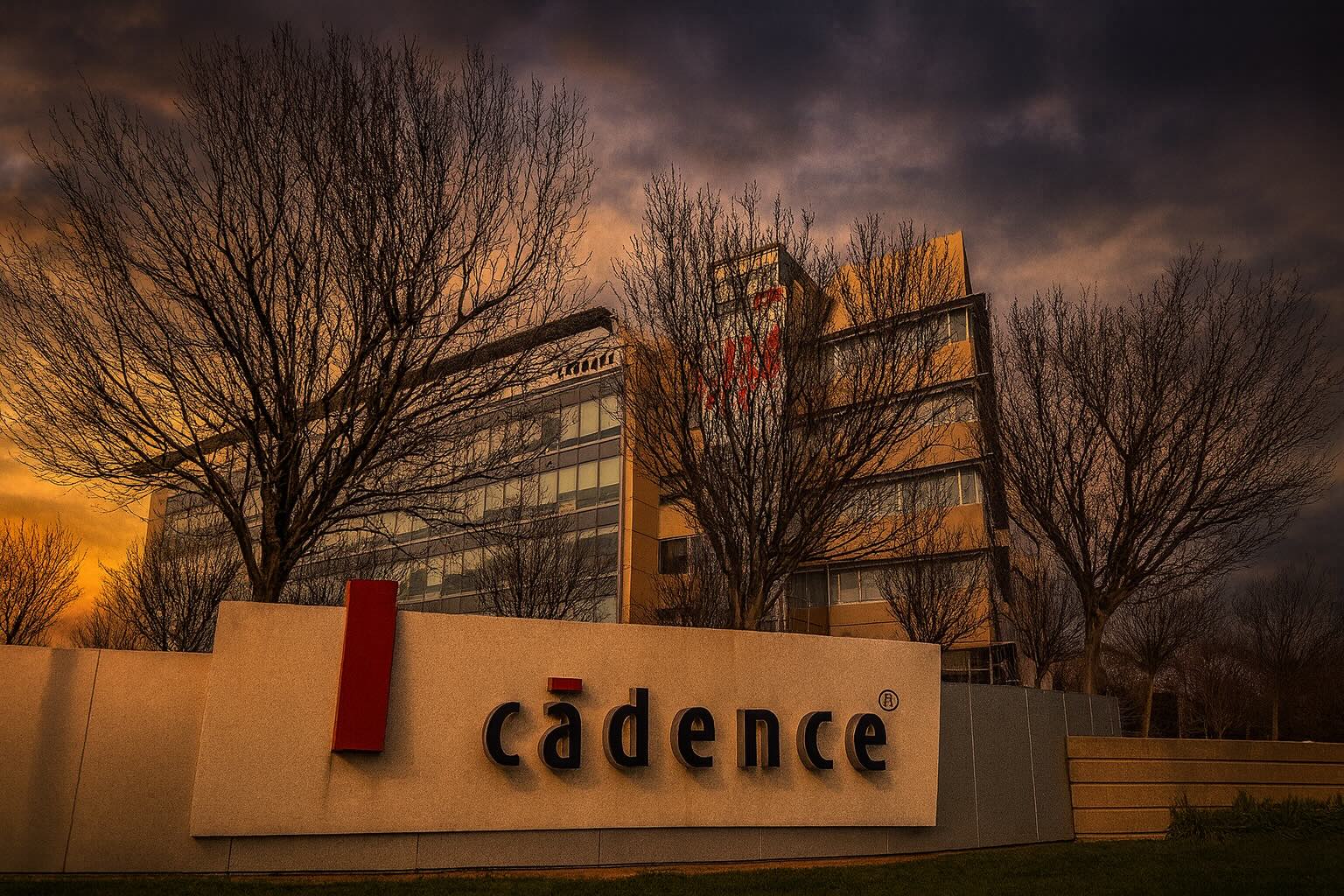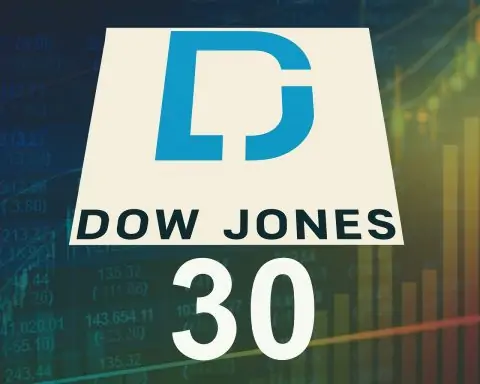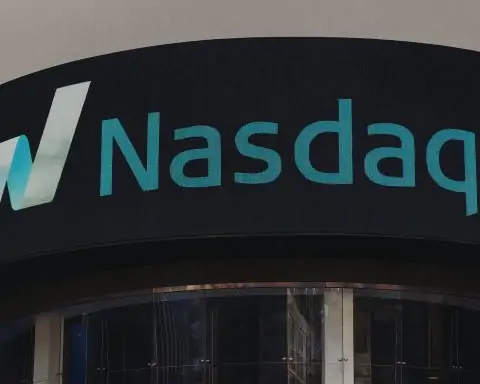- Stock Price: As of October 27, 2025, Cadence Design Systems (NASDAQ: CDNS) trades around the mid-$340s per share, hovering near record highs. The stock is up roughly 6–7% in the past week alone [1] and has climbed about 15–20% year-to-date, outpacing the broader market rally. (CDNS hit an all-time high near $370 over the summer and remains within ~10% of that peak [2].)
- Q3 Earnings Beat: Cadence blew past Q3 2025 estimates, reporting revenue of $1.34 billion (up ~10% YoY) and non-GAAP EPS of $1.93, topping consensus of ~$1.32 billion and $1.78 respectively [3]. GAAP earnings were $1.05/share [4]. Buoyed by robust demand, management raised its full-year outlook: 2025 revenue is now forecast to rise ~14% YoY (to ~$5.26–5.29 billion) with non-GAAP EPS of $7.02–$7.08 [5] – higher than prior guidance. The order backlog hit a record $7 billion [6], signaling strong future demand.
- Stock Reaction: Despite the upbeat results, CDNS shares dipped ~1–2% in post-market trading on Oct 27 [7] [8]. The modest pullback suggests investors had priced in a strong quarter ahead of earnings – the stock had rallied into the report – and may have engaged in profit-taking on the news. Even with this blip, Cadence’s stock remains within striking distance of all-time highs and has broadly “coiled” higher in anticipation of growth [9].
- Breaking News & Catalysts: Cadence is aggressively expanding its portfolio through acquisitions and partnerships. In September, the company agreed to acquire Hexagon’s Design & Engineering (D&E) software business (including the well-known MSC Software simulation tools) for about $3.18 billion(€2.7B) [10]. The deal – expected to close by Q1 2026 – will bolster Cadence’s multiphysics and structural simulation offerings, extending its reach into aerospace, automotive and industrial markets [11] [12]. Cadence also completed the purchase of Arm’s “Artisan” foundation IP business in late August [13], adding key chip design IP (standard cell libraries, memory compilers, etc.) to its arsenal. Meanwhile, Cadence has deepened its partnership with TSMC, collaborating on cutting-edge 3nm/2nm chip design flows and advanced 3D-IC packaging tech to accelerate next-gen semiconductor development [14] [15]. The company is even partnering with NVIDIA on AI data center “digital twin” solutions, integrating Cadence’s simulation platforms with NVIDIA’s DGX SuperPOD AI systems to optimize data center design [16].
- Analyst & Executive Quotes: “Cadence delivered excellent results for the third quarter of 2025. With a record backlog and ongoing broad-based strength of our business, we are raising our full year revenue outlook to ~14% growth year-over-year,” said CEO Anirudh Devgan [17]. Wall Street remains largely bullish. Morgan Stanley recently reiterated an Overweight (Buy) rating with a $360 price target [18], and average analyst targets sit around $370–$380 [19], implying moderate upside. Mizuho last quarter boosted its target to $375 (“Outperform”) and Stifel Nicolaus to $395 (“Buy”), highlighting optimism about Cadence’s growth trajectory [20]. However, there are cautious voices: “Cadence’s valuation already reflects significant growth expectations. Any missteps in execution or a broader slowdown in the semiconductor industry could lead to a correction,” one analyst warned [21], noting the stock’s high earnings multiple.
- Semiconductor Industry Context: Cadence plays a pivotal role in the semiconductor and EDA (electronic design automation) space, which underpins the current AI hardware boom. Its software and IP enable the design of the latest AI chips, 5G devices, and advanced semiconductors [22]. This year’s frenzy in AI investment has lifted all chip-related stocks, and Cadence is no exception – the company has been a “pick-and-shovel” beneficiary of the AI supercycle, supplying tools to countless chipmakers. Nonetheless, industry headwinds exist. Rival Synopsys – Cadence’s main competitor in EDA – issued a cautious outlook amid U.S.-China export restrictions, sending its stock plunging in September and briefly dragging Cadence down ~8% in sympathy [23] [24]. (Synopsys cited new U.S. tech curbs on China for a sales shortfall, sparking fears of an industry-wide slowdown.) Cadence itself navigated similar geopolitical issues: it paid $140 million to settle U.S. charges related to unauthorized sales of its software to China in years past [25]. Fortunately, Washington eased certain export rules this fall, re-opening key Chinese markets to Cadence [26] – a relief that helped restore investor confidence.
- Forecasts – Bull vs. Bear: In the near term, technical signals for CDNS remain encouraging. The stock’s recent consolidation appears to be a bullish “coil” formation, with strong price and earnings momentum – one quantitative model (Validea’s Twin Momentum) gave Cadence a 94% score as a high-quality growth stock, indicating “strong interest” among momentum investors [27]. Many analysts expect Cadence to continue outperforming on the back of the AI and chip design boom, and the firm’s own guidance implies double-digit growth persisting into next year. Longer-term, Cadence’s strategic moves – including the Hexagon simulation acquisition and expanded IP portfolio – are viewed as positioning it for sustained growth in new markets (industrial simulation, multiphysics analysis, etc.). “Cadence’s recent acquisitions signal just how essential chip IP and simulation are to tech infrastructure… fortifying Cadence’s position and fueling the next wave of digital transformation,” noted a Finimize News analysis [28] [29]. However, on the bear side, valuation is a sticking point. Cadence shares trade around 45× forward earnings (over 90× trailing P/E) and ~15× sales, a rich premium even in the high-growth software sector [30]. Simply put, the stock is priced for perfection. Bears argue that any slowdown in EDA spending or integration hiccups with new acquisitions could pressure margins and trigger a re-rating. The sole Sell rating on Wall Street (Oppenheimer) carries a $200 target – reflecting skepticism that Cadence can grow fast enough to justify its lofty valuation [31] [32]. Most observers, though, find Cadence’s growth story compelling in the context of secular semiconductor trends.
CDNS Stock Performance: Near Highs After Steady Climb
Cadence’s stock has been on a steady upward trajectory throughout 2025, riding the broader tech wave. After starting the year around the high-$200s, CDNS surged over the summer amid the AI-driven market rally, peaking around $370 in July [33]. A mid-September pullback – triggered by Synopsys’s China-related warning – saw Cadence briefly dip into the low $330s [34] [35], but the stock quickly rebounded. By late October, CDNS was trading near $350and hitting fresh multi-month highs ahead of earnings [36]. In fact, the stock jumped ~6.6% in the five sessions leading up to the Q3 earnings release [37], reflecting bullish anticipation from investors.
Even accounting for a minor post-earnings dip, Cadence shares are significantly outperforming the market in recent weeks. The company’s strong fundamentals and AI tailwinds have driven a ~35% gain over the past 12 months [38], and year-to-date returns are in the mid-teens to low-20s percentage range. By comparison, the S&P 500 is up around 12% YTD and the Nasdaq ~25% YTD. Cadence’s beta (~1.0) indicates it moves roughly in line with the market, but its consistent uptrend underscores investor confidence in its niche.
Volatility around news: It’s worth noting that CDNS – while generally stable – isn’t immune to swings. The stock has had about a dozen 5%+ moves in the past year [39], often around earnings or industry news. For instance, on Sept 10, shares tumbled over 8% intraday when peer Synopsys’s weak results raised red flags for the whole EDA sector [40]. Conversely, Cadence enjoyed a double-digit pop late last year after a blowout Q3 2024 report (when backlog and billings impressed) [41]. This history implies that sharp moves can occur on major developments, but so far each pullback has been a buying opportunity – Cadence stock has more than tripled in value over the past 5 years [42], rewarding long-term holders.
As of October 27, Cadence’s market capitalization stands near $95 billion [43], placing it among the largest pure-play software companies and firmly in large-cap territory. The stock’s 52-week range is approximately $221 to $371, and at ~$347 it trades about 10% below the peak [44]. With the latest earnings in hand and strong momentum, bulls are watching to see if CDNS can break out to new highs in the coming days. Chart analysts note the stock has been consolidating in the $330–$360 zone for a few months, potentially building energy for its next leg up – supported by rising moving averages and robust volume into earnings. If broader market sentiment stays risk-on (the Nasdaq just hit record highs this week), Cadence could retest its highs in short order. On the flip side, any sign of softness or simply profit-taking could see shares drift back into the mid-$300s near-term. Overall, recent trading action paints a picture of optimism, with Cadence stock “primed for a breakout,” as one market watcher put it [45].
Earnings Blowout: Q3 2025 Highlights and Record Outlook
Cadence’s third quarter 2025 results, reported after the close on Oct 27, affirmed the company’s strong growth story. Revenue jumped to $1.339 billion in Q3, up ~9.9% from $1.215 billion a year ago [46]. This slightly exceeded Wall Street’s $1.33B estimate [47]. Earnings were even more impressive: adjusted EPS of $1.93 beat the $1.79 consensus by ~8% [48] [49]. On a GAAP basis (including stock comp and acquisition costs), EPS was $1.05 [50] [51] – up 21% YoY, reflecting solid operational leverage.
This marks Cadence’s sixth straight quarter of beating earnings expectations, and management struck an upbeat tone about business trends. “Cadence delivered excellent results for Q3,” CEO Anirudh Devgan noted, highlighting “broad-based strength” across product lines and geographies [52]. Notably, the company’s backlog swelled to about $7 billion – an all-time high [53]. A growing backlog (contracted future revenue) is a key positive indicator for Cadence, which mainly sells long-term software licenses and services to chipmakers and system designers. The record backlog suggests clients are locking in multi-year deals for Cadence’s tools, underpinning confidence in future growth.
Thanks to this momentum, Cadence raised its full-year forecast for the second time this year. It now expects FY2025 revenue of approximately $5.26–$5.29 billion, which would represent ~14% growth year-over-year [54]. That’s up from prior guidance of ~13% growth, and above the ~$5.22B analysts’ consensus [55]. Non-GAAP EPS is projected at $7.05 (midpoint), up from around $6.90 before – implying ~16% YoY profit growth [56]. For Q4 2025, Cadence guided adjusted earnings of $1.88–$1.94 per share on revenue of ~$1.36B (midpoint) [57], in line with seasonal expectations (Q4 is typically Cadence’s strongest quarter).
Key drivers in Q3 included continued growth in Cadence’s core EDA software segment as well as strong gains in the newer IP and Systems Design segments. Cadence has successfully expanded beyond traditional chip design tools into semiconductor IP (intellectual property blocks) and system analysis solutions. In fact, the company called out “big wins in our IP division” during the quarter [58]. Cadence recently acquired portions of Rambus’s IP portfolio and, as mentioned, closed the deal for Arm’s foundation IP unit in Q3 [59]. These moves appear to be paying off, adding incremental revenue and cross-selling opportunities. Meanwhile, Cadence’s System Design & Analysis segment (which includes PCB design, multi-physics simulation, etc.) has been a high-growth area – up over 35% YoY in Q2 [60] – and likely continued to see strong demand in Q3 given trends like AI hardware development and electronic systems complexity.
Profitability also improved: Cadence’s operating margin hit ~31.8% in Q3, up from ~28.8% a year ago [61], as revenue growth outpaced expense growth. The company continues to generate hefty free cash flow (over 20% of revenue) [62], enabling ongoing share buybacks and M&A. In the first nine months, Cadence repurchased about $800 million in stock, helping to offset dilution.
Investor reaction: On the earnings call (held Oct 27 evening), management’s confident outlook was evident. Yet Cadence’s stock initially slipped about 1–2% in after-hours trading following the report [63] [64]. By the next morning, shares opened slightly lower around $345. The muted reaction may simply reflect that expectations were high – Cadence’s stock had run up into the print (a “buy the rumor, sell the news” scenario). Additionally, some traders pointed out that Q3’s 10% revenue growth, while solid, was a step-down from 13%+ in H1; and the Q4 EPS guidance, albeit strong, wasn’t a big beat versus consensus. In other words, Cadence delivered a “strong but not shockingly strong” quarter – enough to keep bulls happy, but not enough to spur immediate further stock gains given the rich valuation. As one market strategist commented, “Investors were likely hoping for a larger top-line beat or a bigger guidance hike to push the stock significantly higher. In the absence of that, some profit-taking is natural.” Indeed, Cadence’s shares are up ~40% over the past year, so some consolidation on good news isn’t unusual.
Big picture, the earnings confirmed Cadence’s healthy fundamentals. The company is growing double-digits at scale and riding powerful tailwinds (AI, 5G, automotive chips, etc.). With backlog at record levels and management raising targets, the outlook heading into 2026 appears bright.
Strategic Moves: Acquisitions, Partnerships, and Product Innovation
Cadence’s management has been proactive in extending the company’s reach through strategic acquisitions and alliances in 2025. These moves aim to position Cadence as a one-stop platform for “Intelligent System Design”, covering everything from chip IP to system-level simulation. Here are some of the recent developments shaping Cadence’s strategy:
- $3.2B Hexagon D&E Acquisition: In mid-September, Cadence announced a headline-grabbing deal to acquire the Design & Engineering (D&E) division of Hexagon AB for about $3.18 billion [65]. Hexagon is a Swedish industrial tech firm; the unit Cadence is buying includes MSC Software, a pioneer in computer-aided engineering (CAE) and simulation (known for tools like MSC Nastran, Adams, etc.). This catapults Cadence into the lucrative structural and multiphysics simulation market widely used by aerospace, defense, and automotive companies [66] [67]. The acquisition, expected to close by early 2026 pending approvals [68], will add over $280 million in annual revenue and 1,100 employees to Cadence [69]. More strategically, it expands Cadence’s portfolio beyond electronics into mechanical simulation – letting it offer an integrated platform for designing both the silicon and the physical systems (think aircraft, cars, rockets) that silicon goes into. “This will be a pivotal step in enabling our customers to design the complex, converged systems of tomorrow,” CEO Devgan said of the deal [70]. Industry observers note this move pits Cadence against players like Ansys in the simulation arena, but also brings cross-selling synergies (e.g. a carmaker using Cadence for chip design might now use Cadence for crash simulations too). The market applauded the strategic rationale, though some analysts cautioned that integrating a large acquisition carries execution risk – and Hexagon’s unit was amid a business model transition (to subscriptions) that Cadence will have to continue [71] [72].
- Arm “Artisan” IP Unit Purchase: On August 27, Cadence quietly closed another significant deal – the acquisition of Arm’s “Artisan” foundation IP business [73]. This unit provides fundamental semiconductor IP like standard cell libraries and memory compilers used in chip design. Arm (the British chip IP giant) sold it as part of portfolio refocusing ahead of its IPO. For Cadence, absorbing Arm’s foundation IP (for an undisclosed sum) is highly strategic: it broadens Cadence’s IP catalog and strengthens ties with Arm’s ecosystem. Now Cadence can offer customers not just EDA tools to design chips, but also the critical building-block IP needed to implement those chips on advanced nodes. In effect, Cadence moves a step closer to Synopsys’ model (Synopsys has long had a large IP portfolio alongside its EDA software). Cadence noted the deal should slightly boost its IP revenue and provide new opportunities in markets like mobile and IoT where Arm’s IP is prevalent. The timing was ideal – Cadence wrapped up the Arm IP purchase just in time to incorporate it into late-2025 product offerings [74], and analysts believe it will be accretive to growth in 2026.
- Deepening TSMC Partnership: Cadence’s partnerships are equally important. The company has a long-standing alliance with TSMC, the world’s top semiconductor foundry, to ensure Cadence tools work seamlessly on TSMC’s cutting-edge manufacturing processes. On Oct 1, Cadence and TSMC announced an extension of their collaboration focused on AI-enabled design flows and 3D-IC technologies for TSMC’s most advanced nodes (3nm, 2nm) [75] [76]. Cadence’s AI-driven EDA solutions (like the Cerebrus platform for automated chip floorplanning) are being optimized for TSMC’s N3, N2, and even experimental “A16” nodes [77]. Additionally, Cadence is delivering new silicon-proven IP (e.g. HBM4 high-speed memory interfaces) on TSMC’s latest processes [78] [79]. TSMC, for its part, praised the partnership: “Together with OIP partners like Cadence, we’re addressing the most intricate challenges in semiconductor development… empowering customers to accelerate their journey to silicon,” said an ecosystem director at TSMC [80]. The upshot is Cadence remains at the forefront of the latest chip fabrication breakthroughs, reinforcing its credibility with mutual customers (which include virtually every major chip designer using TSMC fabs). Beyond TSMC, Cadence similarly works with Intel’s foundry and Samsung – but TSMC provides the bulk of leading-edge design activity, so this partnership is critical.
- NVIDIA & Digital Twin Initiative: In September, Cadence also unveiled a collaboration with NVIDIA to integrate Cadence’s Omniverse-based AI “digital twin” platform with NVIDIA’s DGX AI supercomputers [81] [82]. Specifically, Cadence is incorporating a digital twin of NVIDIA’s DGX SuperPOD (an AI data center system) into its Cadence Cerebrus and System Analysis workflows [83]. This allows data center engineers to virtually model and optimize their AI infrastructure (networking, cooling, power, chip performance) using Cadence’s simulation tools before deploying hardware. It’s a niche but forward-looking venture – with AI data centers booming, providing design tools to build better data centers is an emerging opportunity. If successful, Cadence could play a key role in enabling the next generation of AI mega-clusters. The news generated buzz given NVIDIA’s clout; however, some analysts caution the revenue impact is uncertain near-term [84]. It nonetheless showcases Cadence’s intent to be involved in all layers of the AI computing revolution, from chip IP to system-level digital twins.
- Product Innovation – AI and Cloud: Cadence hasn’t slowed its R&D either. This year the company launched Cadence AI-powered tools like the Virtuoso Studio for custom chip design and expanded its AI-driven Cadence Cerebrus platform, which uses reinforcement learning to automate design optimization. Cadence also made waves in an entirely different field – computational drug discovery – with its Cadence Molecular Sciences unit launching “ROCS X”, an AI-enabled platform for screening billions of molecular structures (born from Cadence’s acquisition of OpenEye Scientific in 2022) [85]. While not core to semiconductors, it’s another example of Cadence applying its algorithmic expertise to new domains. All told, Cadence’s innovation pipeline remains robust, with significant investment in cloud-based EDA (important as customers scale design workloads on Amazon/Google Cloud) and AI enhancements across its tool suite. These developments aim to maintain Cadence’s technology edge over rivals and keep customers locked into its ecosystem.
In summary, Cadence’s recent strategic moves – big-ticket acquisitions (Hexagon D&E, Arm IP) plus high-profile partnerships (TSMC, NVIDIA) – underscore the company’s ambition to broaden its footprint from chip design into full system design and analysis. If well executed, these moves could open up multi-billion dollar adjacent markets and sustain Cadence’s growth for years to come. Investors will be watching how these integrations play out in 2026: the Hexagon deal in particular will be transformative, expanding Cadence’s total addressable market by an estimated $5–6 billion (the CAE/simulation market) [86] [87]. Near-term, these initiatives also signal to Wall Street that Cadence is playing offense, not just riding cyclical tailwinds. As CEO Devgan often emphasizes, the vision is for Cadence to be the “design house for the next era of electronics and intelligent systems.” 2025’s moves bring that vision closer to reality.
Cadence’s Role in the Semiconductor & EDA Landscape
To understand Cadence’s investment thesis, it’s crucial to grasp the company’s unique role in the semiconductor value chain. Cadence is one of the “Big Two” in EDA (electronic design automation) software – the specialized tools used to design and verify complex integrated circuits. (The other giant is Synopsys; a third competitor, Mentor Graphics, is smaller and now part of Siemens.) Virtually every modern chip – from Apple’s iPhone processors to NVIDIA’s AI GPUs – goes through design with EDA tools provided by either Cadence or Synopsys. This gives Cadence a quasi-duopoly position in an indispensable niche, with high barriers to entry (decades of R&D, deep customer relationships, and a proven track record are needed to compete).
In practical terms, Cadence’s software is used by chip engineers to lay out transistor circuitry, run simulations, and catch design errors before a chip is ever manufactured. Its flagship platforms – like the Virtuoso suite for analog design and the Innovus/Genus suite for digital design – are industry standards. Because of this entrenched position, Cadence benefits directly from the R&D boom in semiconductors. Whenever companies like Apple, AMD, or Tesla pour more into custom chip development (to enable AI, autonomous driving, etc.), demand for Cadence’s tools increases. Indeed, we’ve seen a surge of startup activity in AI chips, custom silicon being developed by system companies (Amazon, Google designing their own chips), and expansion of chip design in new regions (e.g. China, India). All of these trends expand Cadence’s customer base. “Powering the chips behind everything from smartphones to AI accelerators for over 35 years, Cadence provides essential software, hardware, and IP used by engineers to design advanced electronic systems,” notes StockStory’s overview [88]. It’s a picks-and-shovels business: Cadence doesn’t make chips, but it sells the tools to those who do, making it somewhat agnostic to which chip companies win – as long as the overall pace of chip innovation remains high.
Right now, that pace is very high, thanks to the AI gold rush. The development of AI accelerators and advanced 5nm/3nm chips has created “broad-based strength across our business,” Cadence reported [89]. Notably, AI is a two-fold tailwind: it’s driving new chip designs (which require EDA software), and AI techniques are improving EDA itself. Cadence has been integrating machine learning into its tools (hence products like Cerebrus AI) to help customers design better chips faster, and even using generative AI to assist with tasks like circuit layout optimization [90] [91]. This should increase the productivity (and stickiness) of Cadence’s platform over time. As the Finimize report put it, “With a $7B backlog and a knack for outperforming expectations, investor confidence remains strong – Cadence’s results stand out in a tech sector known for swings” [92]. The adoption of AI in both chips and the chip design process is brightening Cadence’s outlook and perhaps smoothing some cyclicality.
Competition & Risks: While Cadence is riding high, it’s not without competition or risk. Synopsys (SNPS), roughly equal in size to Cadence, competes in many of the same categories (EDA tools and IP). This summer, Synopsys’s stock stumbled when it warned of slower demand from China (due to U.S. export controls affecting sales of EDA for 14nm-and-below designs) [93]. That news briefly spooked Cadence investors – after all, Chinese chip firms are customers of both companies. However, the U.S. government later clarified and lifted certain EDA export restrictions in October, particularly for older chip nodes [94]. This effectively allowed Cadence and Synopsys to resume selling some high-end chip design software to Chinese clients, mitigating a major overhang. Cadence’s settlement of the past export violation (the $140M fine) also clears the slate and should ensure compliance going forward [95]. The episode highlighted geopolitical risk – EDA is at the nexus of U.S.-China tech tensions since it’s critical for chip development. Investors will be watching this space closely, as future export rule changes could again impact demand from China (which can account for 10–15% of Cadence’s revenue by some estimates).
Another competitive angle is the emergence of new EDA entrants or open-source tools, albeit these remain niche. Large cloud companies (like Google, with its in-house “Collos” EDA efforts) and some startups are exploring AI-driven alternatives to traditional tools. Cadence and Synopsys have responded by embracing cloud and AI themselves, and so far their positions remain dominant. The high complexity of modern chip design and the mission-critical nature of these tools make customers reluctant to experiment with unproven vendors for advanced projects – a dynamic that favors Cadence/Synopsys.
Cadence vs. Synopsys stock: It’s worth noting that after Synopsys’s stumble (its shares plunged ~30% in September on the China warning [96]), Cadence actually became the more richly valued of the two for perhaps the first time ever. Cadence’s market cap, ~$95B, now nearly matches Synopsys’s ~$100B, despite Synopsys having slightly higher revenue. This partly reflects Cadence’s strong execution and diversified growth (e.g. its System Analysis segment is outpacing Synopsys’s equivalents, and Cadence’s recent acquisitions are seen as promising). But it also means Cadence has less margin for error – it is priced at a premium. Any sign that Cadence is falling behind Synopsys technologically or losing share could be punished. So far, Cadence appears to be firing on all cylinders, and even capitalizing on Synopsys’s missteps: when Synopsys struggled, Cadence was quick to reassure that its own business remained solid, and indeed Cadence didn’t lower guidance at all.
Overall, Cadence sits in an enviable strategic position: at the intersection of multiple secular trends (AI, 5G, IoT, automotive electrification) that all require more complex chips and systems – which in turn require the EDA software, IP, and simulations Cadence provides. The company’s broadening product suite (now spanning chips to systems) and its heavy R&D investments in AI-driven design put it at the forefront of innovation in the semiconductor ecosystem. As long as the “more chips, more complexity” trend continues, Cadence should have a strong wind at its back.
Analyst Sentiment and Stock Forecasts
Wall Street analysts are generally positive on Cadence Design Systems, although with some reservations about valuation. According to TipRanks, 19 out of 20 analysts covering CDNS rate it a Buy or Overweight, with 1 Hold and 1 Sell (the lone Sell being the outlier from Oppenheimer) [97] [98]. The average 12-month price target is around $370–$375 per share [99], roughly ~7% above the current price – suggesting limited near-term upside if those targets are realized. Several analysts hiked their targets after Q2’s strong results in July: for instance, Wells Fargoraised its target to $405 (from $365) while reiterating an “Overweight” Buy rating, citing “Cadence’s strong outlook”and growth prospects [100] [101]. Needham likewise lifted its target to $390 and Berenberg to $400 in late July, both reiterating Buy ratings [102] [103]. These aggressive targets reflect confidence that Cadence’s expansion into new areas (IP, systems analysis, AI) will sustain a high growth rate.
By contrast, Morgan Stanley’s analyst (Lee Simpson) has been a bit more conservative. On October 21, Morgan Stanley maintained an Overweight rating but kept Cadence’s target at $360 [104], essentially right around the then-current price. This suggests Morgan Stanley sees Cadence as fully valued for now, though still a solid long-term holding. The analyst community as a whole appears to be split between those who cheer Cadence’s execution and potential – thus justifying further upside – and those who worry the stock’s rich multiples cap the near-term gains.
Key bullish arguments from analysts include Cadence’s robust free cash flow and shareholder returns (it’s a FCF machine, funding buybacks), its broadening TAM with moves like Hexagon, and the mission-critical nature of its products which affords pricing power. “Cadence’s strong financial performance and growth prospects lead to [a] Buy rating and increased price target,” wrote Needham’s Charles Shi in reaffirming his bullish stance [105] [106]. Loop Capital similarly noted Cadence’s execution in AI and partnerships, boosting its target to $390 and stating that the higher valuation is justified by an upbeat growth outlook [107]. Another tailwind: institutional investors have been buying. Recent 13F filings showed large holders like Capital World and Wellington adding to positions. One report highlighted that Bridges Investment Management and Applied Finance Capital initiated or increased stakes in Q2 [108], a sign that smart money sees further gains.
On the flip side, valuation concerns dominate the cautious takes. Cadence currently trades at ~50 times next-12-months earnings and over 20 times sales on a GAAP basis – nosebleed levels that assume many years of double-digit growth. As Investing.com’s analysis pointed out, “While trading at a P/E near 94×, [Cadence] appears overvalued relative to its fair value” based on traditional metrics [109]. Sahm Capital echoed that sentiment, suggesting Cadence may be “overvalued by 100%” in a DCF model if growth slows [110]. Piper Sandler actually downgraded the stock in July from Overweight to Neutral, citing the rich valuation – they set a then-low target of $355 (which the stock has since surpassed) [111] [112]. The Oppenheimer analyst with the $200 target essentially believes Cadence is priced far beyond fundamentals and is due for a correction [113].
What about technical forecasts? Some market analysts focus on stock chart patterns and momentum. As noted, Cadence stock has been consolidating below its highs, leading chartists to anticipate a potential breakout if earnings and news flow remain positive. The AskTraders technical team highlighted the stock “coiling towards a breakout” and pointed to the strong relative strength in recent days (RSI rising) and support from moving averages [114]. They also mentioned the possibility of an “either direction” move after earnings, which is common when a stock trades at highs – a big catalyst can either send it surging to new records or trigger a pullback if it disappoints [115]. In Cadence’s case, the absence of a blowout surprise means the stock didn’t break out immediately; however, the uptrend remains intact, and a push above $370 on volume could signal the next leg higher.
Near-term catalysts that analysts are watching include: any additional color on Hexagon deal synergies (Cadence is likely to discuss more at its next earnings or investor day), progress in China business recovery post-export rule changes, and the trajectory of backlog/bookings. If Cadence continues to build backlog and beat numbers, analysts may keep edging targets upward. Conversely, if macro conditions (like a tech spending slowdown or chip inventory correction) hit the industry, Cadence’s highly valued stock could see a multiples contraction.
The consensus sentiment, though, leans optimistic. As Finimize summarized succinctly, “With a $7B backlog and a knack for beating expectations, investor confidence remains strong – share prices have marched higher this year” [116]. The feeling is that Cadence is executing so well and is so essential to the chip boom that it deserves its premium valuation. The company’s moves in AI and system design are seen as forward-thinking, potentially unlocking new growth to sustain elevated earnings expansion beyond the current cycle.
In fact, some bullish analysts argue that Cadence could be an “under-the-radar AI play” for investors looking beyond the obvious NVIDIA/AMD picks. Cadence’s tools are instrumental in designing the very AI chips that power the AI revolution, and thus Cadence profits indirectly from every wave of AI accelerator investment. Plus, Cadence is applying AI to its own products, enhancing margins and differentiation. This thesis has attracted long-term growth investors to the stock.
Bottom line: Analysts expect Cadence to keep growing at a healthy clip (consensus calls for ~10% revenue growth in 2026) [117], and most see the stock as a core holding in the semiconductor software space, even if upside from current levels might be in the single-digit percentages over the next year. Any significant dip, many say, would be a buying opportunity given Cadence’s dominance and secular tailwinds. As one model signaled, Cadence exhibits strong fundamental and price momentum for a large-cap software name [118], which tends to bode well unless the narrative drastically changes.
Outlook: Growth Versus Valuation – Navigating the Road Ahead
Cadence Design Systems finds itself at a crossroads of high growth and high expectations. On one hand, the company is firing on all cylinders – posting record results, expanding into new markets, and sitting at the center of multiple tech megatrends. Its near-term prospects look bright: demand for chip design and simulation tools remains robust, and Cadence’s broadened portfolio means it can capture a larger wallet share from customers (for example, selling IP and systems analysis in addition to EDA software). Wall Street expects double-digit growth to continue into 2026, and Cadence’s own aggressive investments (in AI-driven design, cloud, acquisitions) indicate management is pushing to sustain momentum. There is even speculation that, over the long term, Cadence and Synopsys could become takeover targets for big industrial software conglomerates or cloud giants, given the critical role of EDA in technology – though no concrete moves there, just industry chatter.
On the other hand, valuation and macro risks warrant caution. Cadence’s stock is unquestionably priced for robust growth. The price-to-earnings-to-growth (PEG) ratio is high, implying a lot of future success is already reflected in the share price. If the semiconductor cycle were to hit a soft patch (for instance, if AI spending moderates or a glut forms in some chip segments), Cadence’s growth could slow, and the stock might de-rate similar to other software names that saw multiple compression. Moreover, integrating Hexagon’s D&E business next year will be a test – large acquisitions can come with culture and execution challenges, and investors will be keen to see that business contribute as planned (the deal will slightly dilute Cadence’s operating margin in the short run due to lower software-like margins in the acquired unit). Any hiccups in integration or in the Hexagon unit’s performance could weigh on Cadence’s earnings trajectory or distract management.
There’s also the competitive dynamic: Synopsys isn’t standing still and is expected to bounce back from its recent stumble (Synopsys’s CEO said they see China stabilizing and their AI-enabled tools gaining traction). If Synopsys were to, say, secure a blockbuster deal or make its own big acquisition, the market could rotate attention. Cadence must keep executing to stay ahead in the innovation curve.
Technical view going forward: If Cadence’s stock can decisively break through the ~$370 resistance level, technicians see room toward $400 (which coincidentally is near some analysts’ bull-case targets) in the coming months, especially if year-end market dynamics (like seasonal tech strength and potential Fed rate cuts) provide a tailwind. Conversely, if the stock fails to make new highs and slips below support around $330, it could test the low-$300s where longer-term moving averages lie. That said, with the broader market at record highs and Fed policy turning dovish, the environment for high-growth tech stocks like Cadence is relatively favorable as of late 2025 [119] [120].
Investors should also watch macro factors such as the outcome of U.S.–China trade talks (there’s optimism about a deal in late October that has fueled a market rally [121]) and any changes in the interest rate/risk premium for tech stocks – Cadence, being growth-oriented, is sensitive to interest rate expectations. At the moment, cooling inflation and anticipated Fed rate cuts are boosting growth stock valuations broadly [122] [123], which provides some cushion for Cadence’s high multiple.
In conclusion, Cadence Design Systems enters Q4 2025 as a company executing near flawlessly amid a semiconductor boom, with a slew of new opportunities on the horizon from its acquisitions and industry partnerships. The stock has been a strong performer, reflecting that success. Going forward, the story will be about balancing growth versus expectations. Cadence’s challenge (and opportunity) is to keep delivering innovation and results that justify its premium. If it does, there’s room for the stock to continue climbing steadily, as many top analysts predict. If not – if growth hiccups or external headwinds hit – the stock’s rich valuation could amplify any downside.
For now, most signs point to Cadence staying on an upward trajectory. The company’s own optimism (raising guidance, investing in new tech) and the heavy demand for chips to power AI, cloud, and beyond provide a solid foundation. As Carson Group’s Ryan Detrick noted about the tech sector’s earnings season, “It’s been a spectacular start…justifying the rally” [124] – Cadence is certainly part of that narrative, justifying the confidence investors have placed in it. Cadence has become a quiet powerhouse behind the tech we use every day, and if the coming quarters mirror the last, CDNS stock could well continue its ascent – albeit with eyes wide open toward the valuation and integration milestones that lie ahead.
Sources: Cadence Design Systems Q3 2025 Earnings Release and Call; Manufacturing Dive (Sept 16, 2025); Finimize News [125] [126]; StockStory analyses [127] [128]; AskTraders Technical Update (Oct 27, 2025) [129] [130]; Morgan Stanley Research via Futunn [131]; Business Wire Press Release (Cadence & TSMC, Sept 2025) [132]; Yahoo Finance/Reuters; TS2 Tech Market Reports [133]; Bloomberg; Zacks Investment Research; Investor’s Business Daily; and Yahoo Finance.
References
1. www.asktraders.com, 2. finviz.com, 3. finimize.com, 4. www.nasdaq.com, 5. finimize.com, 6. finimize.com, 7. seekingalpha.com, 8. seekingalpha.com, 9. www.asktraders.com, 10. www.manufacturingdive.com, 11. www.manufacturingdive.com, 12. www.manufacturingdive.com, 13. finimize.com, 14. www.businesswire.com, 15. www.businesswire.com, 16. www.asktraders.com, 17. stockstory.org, 18. news.futunn.com, 19. www.asktraders.com, 20. www.asktraders.com, 21. www.asktraders.com, 22. finimize.com, 23. finviz.com, 24. finviz.com, 25. www.asktraders.com, 26. www.asktraders.com, 27. ts2.tech, 28. finimize.com, 29. finimize.com, 30. www.investing.com, 31. www.tipranks.com, 32. www.tipranks.com, 33. finviz.com, 34. finviz.com, 35. finviz.com, 36. www.asktraders.com, 37. www.asktraders.com, 38. finance.yahoo.com, 39. finviz.com, 40. finviz.com, 41. finviz.com, 42. finviz.com, 43. stockstory.org, 44. finviz.com, 45. www.asktraders.com, 46. www.nasdaq.com, 47. stockstory.org, 48. stockstory.org, 49. www.timesunion.com, 50. www.nasdaq.com, 51. www.timesunion.com, 52. stockstory.org, 53. stockstory.org, 54. stockstory.org, 55. finimize.com, 56. stockstory.org, 57. www.timesunion.com, 58. finimize.com, 59. finimize.com, 60. www.sahmcapital.com, 61. stockstory.org, 62. stockstory.org, 63. seekingalpha.com, 64. seekingalpha.com, 65. www.manufacturingdive.com, 66. www.manufacturingdive.com, 67. www.manufacturingdive.com, 68. www.manufacturingdive.com, 69. www.manufacturingdive.com, 70. www.manufacturingdive.com, 71. www.manufacturingdive.com, 72. www.asktraders.com, 73. finimize.com, 74. finimize.com, 75. www.businesswire.com, 76. www.businesswire.com, 77. www.businesswire.com, 78. www.businesswire.com, 79. www.businesswire.com, 80. www.businesswire.com, 81. finviz.com, 82. finviz.com, 83. www.asktraders.com, 84. www.asktraders.com, 85. finviz.com, 86. www.manufacturingdive.com, 87. www.manufacturingdive.com, 88. stockstory.org, 89. stockstory.org, 90. ts2.tech, 91. ts2.tech, 92. finimize.com, 93. finviz.com, 94. www.asktraders.com, 95. www.asktraders.com, 96. finviz.com, 97. www.tipranks.com, 98. www.tipranks.com, 99. www.asktraders.com, 100. www.tipranks.com, 101. www.tipranks.com, 102. www.tipranks.com, 103. www.tipranks.com, 104. news.futunn.com, 105. www.tipranks.com, 106. www.tipranks.com, 107. www.tipranks.com, 108. www.asktraders.com, 109. www.investing.com, 110. www.sahmcapital.com, 111. www.tipranks.com, 112. www.tipranks.com, 113. www.tipranks.com, 114. www.asktraders.com, 115. www.asktraders.com, 116. finimize.com, 117. stockstory.org, 118. ts2.tech, 119. ts2.tech, 120. ts2.tech, 121. ts2.tech, 122. ts2.tech, 123. ts2.tech, 124. ts2.tech, 125. finimize.com, 126. finimize.com, 127. stockstory.org, 128. finviz.com, 129. www.asktraders.com, 130. www.asktraders.com, 131. news.futunn.com, 132. www.businesswire.com, 133. ts2.tech







